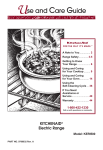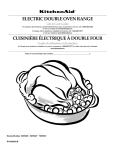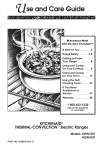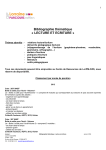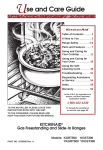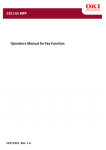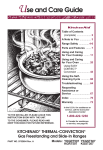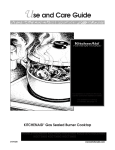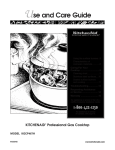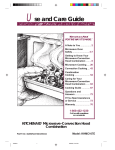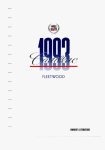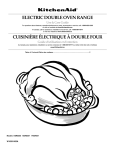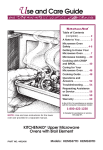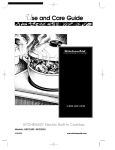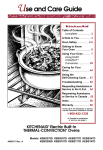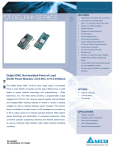Download KitchenAid KERS507 User's Manual
Transcript
Use and Care Guide ® FOR THE WAY IT’S MADE.™ A Note to You ............... 2 Range Safety ............. 3-5 Getting to Know Your Range .................. 6 Using and Caring for Your Cooktop ......... 9 Using and Caring for Your Oven............. 15 Using the SelfCleaning Cycle ........... 45 If You Need Assistance or Service ........................ 49 Warranty ..................... 52 1-800-422-1230 Call us with questions or comments. KITCHENAID® THERMAL-CONVECTION™ Electric Range Model: KERS507 PART NO. 9780934 Rev. A A Note to You Thank you for buying a KITCHENAID ® appliance! KitchenAid designs the best tools for the most important room in your house. To ensure that you enjoy many years of trouble-free operation, we developed this Use and Care Guide. It contains valuable information concerning how to operate and maintain your new appliance properly and safely. Please read it carefully. Also, please complete and mail the enclosed Product Registration Card. Please record your model’s information. Whenever you call our Consumer Assistance Center at 1-800-422-1230 or request service for your appliance, you need to know your complete model number and serial number. You can find this information on the model and serial number plate (see diagram on page 6 for location of plate). Please also record the purchase information. Model Number __________________________ Serial Number __________________________ Purchase/ Installation Date ________________________ Builder/Dealer Name _________________________________ Address _______________________________ Phone _________________________________ NOTE: You must provide proof of purchase or installation date for in-warranty service. Keep this book and the sales slip together in a safe place for future reference. 2 Range Safety IMPORTANT SAFETY INSTRUCTIONS Your safety is important to us. This guide contains safety symbols and statements. Please pay special attention to these symbols and follow any instructions given. Here is a brief explanation of the use of the symbol. wWARNING This symbol alerts you to hazards such as fire, electrical shock, or other injuries. To reduce the risk of fire, electrical shock, injury to persons, or damage when using the range, follow basic precautions, including the following: General • Read all instructions before using the range. • Install or locate the range only in accordance with the provided Installation Instructions. The range must be installed by a qualified installer. The range must be properly connected to electrical supply and grounded. • WARNING: To reduce the risk of tipping the appliance, the appliance must be secured by a properly installed anti-tip bracket. To check if the bracket is installed properly, see “The anti-tip bracket” on page 8. • CAUTION: Do not store things children might want above the range. Children could be burned or injured while climbing on it. • Do not leave children alone or unattended in area where the range is in use. They should never be allowed to sit or stand on any part of the range. They could be burned or injured. • Do not use the range for warming or heating the room. Persons could be burned or injured, or a fire could start. • Use the range only for its intended use as described in this manual. • Do not touch surface units, areas near units, heating elements, or interior surfaces of oven. Surface units and heating elements may be hot even though they are dark in color. Areas near surface units and interior surfaces of an oven become hot enough to cause burns. During and after use, do not touch, or let clothing or other flammable materials contact surface units, areas near units, heating elements, or interior surfaces of oven until they have had sufficient time to cool. Other surfaces of the range, such as the oven vent opening, the surface near the vent opening, the cooktop, and the oven door and window, could also become hot enough to cause burns. continued on next page 3 Range Safety • Do not operate the range if it is damaged or not working properly. •Do not wear loose or hanging garments when using the range. They could ignite if they touch a hot surface unit and you could be burned. •Use only dry pot holders. Moist or damp pot holders on hot surfaces could result in burns from steam. Do not let pot holder touch hot heating elements. Do not use a towel or bulky cloth for a pot holder. It could catch on fire. •Keep range vents unobstructed. •Do not heat unopened containers. They could explode. The hot contents could cause burns and container particles could cause injury. •Use only cookware approved for oven use. Follow cookware manufacturer’s instructions, especially when using glass or plastic cookware. •Do not store flammable materials on or near the range. The fumes could create an explosion and/or fire hazard. •Do not repair or replace any part of the range unless specifically recommended in this manual. All other servicing should be referred to a qualified technician. •Disconnect the electrical supply before servicing the range. 4 When using the cooktop •Make sure the reflector bowls are in place during cooking. Cooking without reflector bowls could subject the wiring and components underneath them to damage. •Do not line reflector bowls with aluminum foil or other liners. Improper installation of these liners could result in a risk of electrical shock or fire. •Select a pan with a flat bottom that is about the same size as the surface unit. If pan is smaller than the surface unit, some of the heating element will be exposed and could result in the igniting of clothing or pot holders. Correct pan size also improves cooking efficiency. •Check to be sure glass cookware is safe for use on the range. Only certain types of glass, glassceramic, ceramic, earthenware, or other glazed cookware are suitable for cooktops without breaking due to the sudden change in temperature. •Never leave surface units unattended at high heat settings. A boilover could result and cause smoking and greasy spillovers that could ignite. Range Safety • Use care when opening oven door. • Turn pan handles inward, but not over other surface units. This will help reduce the chance of burns, igniting of flammable materials, and spills due to bumping of the pan. • Grease is flammable. Do not allow grease to collect around cooktop or in vents. Wipe spillovers immediately. • Do not use water on grease fires. Never pick up a flaming pan. Smother flaming pan on range by covering with a well-fitted lid, cookie sheet, or flat tray. Flaming grease outside of pan can be extinguished with baking soda or, if available, a multipurpose dry chemical or foam-type extinguisher. • Do not soak removable heating elements in water. The element will be damaged and shock or fire could result. When using the oven • Always position oven rack(s) in Let hot air or steam escape before removing or replacing food. • Small amounts of formaldehyde and carbon monoxide are given off in the Self-Cleaning cycle from fiberglass insulation and food decomposition. Significant exposure to these substances can cause cancer or reproductive harm. Exposure can be minimized by venting with a hood or open window and wiping out excess food spills prior to self-cleaning. • Do not use oven cleaners. No commercial oven cleaner or oven liner protective coating of any kind should be used in or around any part of the oven. • Before self-cleaning the oven, remove broiler pan, broiler grid, oven racks, and other cookware. Do not use your oven to clean miscellaneous parts unless you are instructed to do so in this Use and Care Guide. • Do not clean door gasket. It is essential for a good seal. Care should be taken not to rub, damage, or move the gasket. Clean only parts recommended in this Use and Care Guide. desired location while oven is cool. If a rack must be removed while oven is hot, do not let pot holder contact hot heating element in oven. – SAVE THESE INSTRUCTIONS – 5 G etting to Know Your Range This section tells you what features your range has and where they are located. It also discusses some safety and convenience features that you should know about, but which are not needed to operate the range. Please review this information before using your range. Feature locations QuickSet guide Control panel TOP LIGHT START Cooktop light Oven vent CLEAN DELAY CLEAN DEHYD • MAXI •• ECONO ON TIMED LOCKED ROTIS HR MIN MIN SEC 4 5 6 7 8 9 STOP TIMER CLEAN START START? N CONVECTIO BAKE AUTO SET BROIL ENTER 3 2 1 BROIL BAKE CANCEL OFF ROAST TEMP PROBE KITCHEN D DELAY/TIME STOP TIME START TIME CLOCK SET OVEN LIGHT SET TIMER O CANCEL • MIN •• HRS Plug-in surface unit Model and serial number plate Automatic oven light switch Anti-tip floor bracket Broil element (not shown) Bake element Removable storage drawer (containing broiler pan and grid) Control panel Left rear control knob Display Right rear control knob Cooktop light switch TOP LIGHT TEMP PROBE START TIME STOP TIME KITCHEN TIMER CLOCK SET OVEN LIGHT SET • MIN •• HRS CANCEL OFF MED O O I 9 DH 6 8 CANCEL OFF ME MIN SEC I HR MIN CLEAN START STOP TIMER L 5 7 ON START? O ENTER DH 4 START ROAST DELAY/TIMED AUTO SET 3 ME I DH ME I DH TIMED LOCKED ROTIS 2 M ED L O M ED L O ME BROIL 1 HI L DELAY CLEAN DEHYD CONVECTION BAKE MED REAR REAR MED MED FRONT FRONT Left front control knob 6 CLEAN M ED L O HI M ED L O OFF O BROIL • MAXI •• ECONO HI BAKE L OFF HI L OFF O Electronic oven control Right front control knob G etting to Know Your Range The oven vent wWARNING Oven vent Hot air and moisture escape from the oven through a vent under the left rear surface unit. You can cook on the unit or keep food warm on it while the oven is on. The vent is needed for air circulation. Do not block the vent by using large pans or covers. Poor baking/roasting can result. Burn Hazard Use pot holders when touching items left near oven vent. Failure to do so can result in burns. NOTE: Plastic utensils left over the vent can melt. The storage drawer You can remove the storage drawer to make it easier to clean under the range and to check for installation of the anti-tip bracket. Use care when handling the drawer. Replacing the storage drawer: Removing the storage drawer: Drawer slide rail 1. Empty drawer of any pots and pans before removing drawer. Use recessed area on top edge of drawer to pull drawer straight out to the first stop. Lift front and pull out to the second stop. 2. Lift back slightly and slide drawer all the way out. 1. Fit ends of drawer slide rails into the drawer guides on both sides of opening. 2. Lift drawer front and press in until metal stops on drawer slide rails clear white stops on drawer guides. Lift drawer front again to clear second stop and slide drawer closed. 7 G etting to Know Your Range The anti-tip bracket The range will not tip during normal use. However, tipping can occur if you apply too much force or weight to the open door without the anti-tip bracket properly secured. wWARNING Tip Over Hazard Connect anti-tip bracket to the range. Reconnect anti-tip bracket, if the range is moved. Do not push down on the open oven door. Follow the Installation Instructions. Do not let children climb onto the oven door. Failure to follow these instructions can result in death, burns, or other injury. To verify the anti-tip bracket is engaged: Rear leveling foot • Remove the storage drawer. (See page 7.) • Look to see if the anti-tip bracket is attached to floor with screws. • Make sure left rear leveling foot is positioned under the anti-tip bracket. • See Installation Instructions for further details. 8 and Caring for Your Using Cooktop This section tells you how to operate the controls to the cooktop. It also includes tips on how to cook with and maintain the cooktop. IN THIS SECTION Using the surface units ...................... 9 Cleaning your cooktop ....................... 13 Cookware tips ................................... 10 Using and replacing the cooktop light ........................................ 14 Caring for your cooktop ................... 11 Using the surface units wWARNING OFF LO HI MED HI MED LO MED FRONT Control knobs Push in control knobs before turning them to a setting. Set them anywhere between HI and OFF. Power on lights Each control knob has a Power On Light. When you use a control knob to turn on a surface unit, that knob’s Power On Light will glow. Fire Hazard Turn off all controls when done cooking. Failure to do so can result in death, fire, or burns. Control setting guide For best results, start cooking at the high setting; then turn the control knob down to continue cooking. SETTING HI 6MED HI5 MED 3MED LO2 LO RECOMMENDED USE • To start foods cooking. • To bring liquids to a boil. • To hold a rapid boil. • To fry chicken or pancakes. • For gravy, pudding, and icing. • To cook large amounts of vegetables. • To keep food cooking after starting it on a higher setting. • To keep food warm until ready to serve. 9 U sing and Caring for Your Cooktop Cookware tips • Select a pan that is about the same size as the surface unit. NOTE: Do not leave empty cookware, or cookware which has boiled dry, on a hot surface unit. The cookware could overheat and damage the cookware or surface unit. Home canning information Center over surface unit Pan Surface unit • NOTE: For best results and greater energy efficiency, use only flat-bottomed cookware that makes good contact with the surface units. Cookware with rounded, warped, ribbed (such as some porcelain enamelware), or dented bottoms could cause severe overheating, which damages the cookware and/or surface unit. You can, however, use the newer cookware available with slightly indented bottoms or very small expansion channels. This cookware is specially designed to provide the good contact needed for best cooking results. Also, woks, canners, and teakettles with flat bottoms suitable for use on your cooktop are now available in most stores that sell housewares. • The pan should have straight sides and a tight-fitting lid. • Choose medium to heavy gauge (thickness) pans that are fairly lightweight. • The pan material (metal or glass) affects how fast heat transfers from the surface unit through the pan material and how evenly heat spreads over the pan bottom. Choose pans that provide the best cooking results. • Handles should be made of sturdy, heatresistant material and be securely attached to the pan. 10 • Use the largest surface unit for best results. Also, use a canner/pan which can be centered over the surface unit. Large diameter canners/pans, if not properly centered, trap heat and can cause damage to the cooktop. • Start with hot water. This reduces the time the control is set on high. Reduce heat setting to lowest position needed to keep water boiling. • Keep reflector bowls clean for best heat reflection. • Refer to your canner manual for specific instructions. Optional canning kit The large diameter of most water-bath or pressure canners combined with high heat settings for long periods of time can shorten the life of regular surface units and cause damage to the cooktop. If you plan to use the cooktop for canning, we recommend the installation of a Canning Kit. Order the kit (Part No. 242905) from your KitchenAid dealer, or call 1-800-422-1230 and follow the instructions and telephone prompts you hear. U sing and Caring for Your Cooktop Caring for your cooktop Your cooktop is designed for easy care. You can do most cleaning with items found around your home. Cleaning your cooktop whenever spills or soiling occurs will help to keep it looking and operating like new. NOTE: Let cooktop cool before cleaning. Removing surface units and reflector bowls for cleaning Removing OFF LO HI MED HI MED LO MED FRONT 1. Make sure all surface units are off and cool before removing surface units and reflector bowls. 3. Pull the surface unit straight away from the receptacle. 2. Lift the edge of the unit, opposite the receptacle, just enough to clear the reflector bowl. 4. Lift out the reflector bowl. See “Cleaning your cooktop” on page 13 for cleaning instructions. 11 U sing and Caring for Your Cooktop Replacing OFF LO HI MED HI MED LO MED FRONT 1. Make sure all surface units are off and cool before replacing surface units and reflector bowls. NOTE: Reflector bowls reflect heat back to the cookware on the surface units. They also help catch spills. When they are kept clean, they reflect heat better and look new longer. If a reflector bowl gets discolored, some of your cookware may not be flat enough, or some may be too large for the surface unit. In either case, some of the heat that’s meant to go into or around cookware goes down and heats the reflector bowl. This extra heat can discolor it. Cleaning under the lift-up cooktop 1. Lift front of cooktop at both front corners until the support rods lock into place. 2. Line up openings in the reflector bowl with the surface unit receptacle. 3. Hold the surface unit as level as possible with the terminal just started into the receptacle. Push the surface unit terminal into the receptacle. 4. When terminal is pushed into the receptacle as far as it will go, push down the edge of the surface unit opposite the receptacle. 12 2. Wipe with warm, soapy water. Use a soapy steel-wool pad on heavily soiled areas. 3. To lower the cooktop, lift cooktop from both sides while pushing the support rods back to unlock them. Lower the cooktop into place. U sing and Caring for Your Cooktop Cleaning your cooktop wWARNING Explosion Hazard Do not store flammable materials such as gasoline near this appliance. Doing so can result in death, explosion, fire, or burns. PART WHAT TO USE HOW TO CLEAN Coil element surface units No cleaning required • Spatters or spills will burn off. • Do not immerse in water. Porcelainenamel reflector bowls Nonabrasive, plastic scrubbing pad and warm, soapy water OR The Self-Cleaning cycle • Wipe off excess spills. • Wash, rinse, and dry thoroughly. Sponge and warm, soapy water • Wash, wipe with clean water, and dry thoroughly. • Use nonabrasive, plastic scrubbing pad on heavily soiled areas. • Do not use abrasive or harsh cleansers. They may damage the finish. NOTE: Do not allow foods containing acids (such as vinegar, tomato, or lemon juice) to remain on surface. Acids may remove the glossy finish. Also wipe up milk or egg spills when cooktop is cool. Cooktop surface OR • Place upside down on oven racks in oven during the Self-Cleaning cycle. 13 U sing and Caring for Your Cooktop Using and replacing the cooktop light The fluorescent light is on the top of the control panel. The cooktop light switch is on the control panel. Press it to turn on the cooktop light. Press it again to turn light off. Replacing the cooktop light: 1. Unplug appliance or disconnect at main power supply. CLEAN BROIL DELAY CLEAN DEHYD • MAXI •• ECONO BAKE ON TIMED LOCKED ROTIS If the cooktop light still does not work, you may need to replace the starter. The starter is a knob-shaped part located on the right side of the backguard, under the light bulb. HR MIN STOP CLEAN START START? N CONVECTIO BROIL BAKE ROAST DELAY/TIMED STOP TIME CLOCK SET START TIME TEMP PROBE AUTO SET OVEN LIGHT 2. Flip up the top of the control panel. CLEAN BROIL BAKE DELAY CLEAN DEHYD • MAXI •• ECONO TIMED LOCKED ROTIS ON HR MIN STOP CLEAN START START? N CONVECTIO BAKE AUTO SET BROIL ROAST TEMP PROBE DELAY/TIMED STOP TIME START TIME CLOCK SET OVEN LIGHT 3. Grasp the fluorescent tube at both ends. Turn the tube approximately 90° in either direction until both ends come out of the receptacles. Replace with a 20-watt coolwhite fluorescent tube. 14 To remove and replace the starter, first remove light bulb. Push starter in and turn approximately 90° counterclockwise. Pull starter out of recessed area. You can find replacement starters at stores that sell fluorescent tubes. 4. Close the top panel. Plug in appliance or reconnect at main power supply. and Caring for Your Using Oven This section tells you, step by step, how to operate all oven functions controlled by the electronic control. Carefully follow these instructions, along with the cooking tips and cleaning information, for successful use of your range. IN THIS SECTION Using the electronic oven control ................................................ 15 Broiling............................................... 28 Oven settings .................................... 17 Timed cooking ................................... 33 Setting the clock ............................... 18 Dehydrating ....................................... 36 Using the kitchen timer .................... 18 Raising (proofing) bread .................. 38 Baking or convection baking........... 20 Cooking tips ...................................... 39 Roasting ............................................ 21 Cleaning your oven and controls .............................................. 42 Adjusting oven temperature ............ 23 Using the temperature probe........... 24 Using auto set ................................... 27 Convection broiling .......................... 30 Using and replacing the oven light(s) ................................................ 44 Using the electronic oven control For a quick reference guide on using the electronic oven control, see the QuickSet Guide under the cooktop light cover. BAKE BROIL • MAXI •• ECONO CLEAN DELAY CLEAN DEHYD CONVECTION BAKE BROIL TIMED LOCKED ROTIS HR MIN Thermal oven command pads 2 3 4 5 6 7 8 9 START START? MIN SEC ENTER CLEAN START STOP TIMER ROAST DELAY/TIMED AUTO SET 1 ON TEMP PROBE START TIME STOP TIME KITCHEN TIMER CLOCK SET Convection oven command pads Display/clock • When you first plug in the range, a tone will sound and the display will show “88:88.” If, after you set the clock (page 18), the display again shows “88:88,” your electricity was off for a while. Reset the clock. • The time display will show “Err” and three short tones will sound if a time or temperature is incorrectly entered. OVEN LIGHT SET • MIN •• HRS CANCEL O CANCEL OFF Number pads Starting an operation START ENTER After programming a function, you must press the Start/Enter pad to start the function. If you do not press the Start/Enter pad within 5 seconds of programming, “START?” will show in the display as a reminder. 15 U sing and Caring for Your Oven Canceling an operation CANCEL OFF The Cancel/Off pad will cancel any function, except for the Clock Set and Kitchen Timer functions. When you press the Cancel/Off pad, the large display will show the time of day. Changing audible signals Audible signals tell you if a function is entered correctly or not. They also tell you when a cycle is completed. To shut off audible signals during programming: PRESS and hold for 4 seconds START TIME To shut off all signals except for the end-of-timer tone: PRESS and hold for 4 seconds STOP TIME To change the end-of-timer tone to a 4-second tone: PRESS and hold for 4 seconds SET •MIN ••HR A short tone will sound to tell you the signals have been changed. Repeat step above to turn the signals back on. 16 U sing and Caring for Your Oven Oven settings This chart tells you when to use each setting. It also explains what elements heat up for each setting. SETTING DIAGRAM SETTING INFORMATION BAKE Use this setting for baking and heating casseroles. • The bottom element and outer top element heat up. • During baking, the elements will turn on and off to maintain the oven temperature. BROIL (MAXI/ECONO) Use this setting for broiling regular-sized and smaller cuts of meat, poultry, and fish. • Both top elements heat during Maxi Broil. (Maximum browning coverage) • Only the inner element heats up during Econo Broil. (Browning coverage in center only) CONVECTION BAKE Use this setting for foods which require gentle heating and for baking breads and cakes. Use also when baking large quantities of food on more than one oven rack. • For faster preheating, the bottom element and outer top element heat up until oven reaches desired temperature. After preheat, only the rear element heats up. • For even heating, the fan at the back of the oven circulates air in the oven cavity. CONVECTION BROIL Use this setting for broiling thick cuts of meat. • Both top elements heat up. • For even heating, the fan at the back of the oven circulates air in the oven cavity. CONVECTION ROAST Use this setting for roasting and baking on one rack. • The bottom element and outer top element heat up. • For even heating and faster cooking, the fan at the back of the oven circulates air in the oven cavity. CLEAN Use this setting for selfcleaning only. • The bottom element and outer top element heat up. 17 U sing and Caring for Your Oven Setting the clock 1. Choose Clock Set. PRESS CLOCK SET Example: YOU SEE HR MIN MIN SEC CLEAN START STOP TIME 2. Set time. Example: PRESS 3 3 0 Example: YOU SEE HR MIN MIN SEC CLEAN START STOP TIME 3. Start clock. PRESS START ENTER If the time has not been entered correctly, three short tones will sound and “Err” is displayed for 1 second. The previous display then reappears. Repeat Steps 1, 2, and 3 to re-enter the time of day. Using the kitchen timer The Kitchen Timer does not start or stop the oven. It works like a regular kitchen timer. It can be set in hours and minutes up to 99 hours, 99 minutes, or in minutes and seconds up to 99 minutes, 99 seconds. 1. Choose Kitchen Timer. PRESS once to count down minutes and seconds SET YOU SEE •MIN ••HR HR MIN MIN SEC CLEAN START STOP TIMER 18 U sing and Caring for Your Oven PRESS twice to count down hours and minutes YOU SEE SET •MIN ••HR SET HR MIN •MIN ••HR MIN SEC CLEAN START STOP TIMER 2. Set time. Example: PRESS 3 0 0 0 Example: YOU SEE HR MIN MIN SEC CLEAN START STOP TIMER 3. Start Kitchen Timer. PRESS START ENTER The Kitchen Timer will begin counting down immediately after you press the Start/Enter pad. When time is up, you will hear a single tone that sounds every 5 seconds. KITCHEN/ TIMER PRESS to turn off tone CANCEL YOU SEE HR NOTE: To change the end-of-timer tone to a 4-second tone, press and hold the Kitchen Timer Set pad for 4 seconds. A short tone will sound to tell you the tone has been changed. MIN CLEAN START STOP TIMER To cancel the Kitchen Timer: KITCHEN/ TIMER PRESS CANCEL 19 U sing and Caring for Your Oven Baking or convection baking 1. Position racks. For correct rack placement, see “Rack positions” on page 39 and “Rack placement” chart on page 40. NOTES: • Before turning on the oven always place oven racks where you need them. • Be sure rack(s) is level. • Use pot holders or oven mitts to protect hands if rack(s) must be moved while oven is hot. • Do not let pot holder or oven mitt touch hot elements. 2. Choose setting. PRESS YOU SEE BAKE DELAY CLEAN DEHYD OR TIMED LOCKED ROTIS ON START? CONVECTION PRESS BAKE YOU SEE DELAY CLEAN DEHYD TIMED LOCKED ROTIS ON START? 3. Set temperature (optional). Do this step if you want to set a temperature other than 350°F (for Bake) or 325°F (for Convection Bake). Example: PRESS 3 7 5 Example For Bake: YOU SEE DELAY CLEAN DEHYD (See a reliable cookbook or your convection oven cookbook for temperature recommendations.) 20 TIMED LOCKED ROTIS START? ON U sing and Caring for Your Oven 4. Preheat oven. PRESS START Example For Bake: YOU SEE ENTER DELAY CLEAN DEHYD TIMED LOCKED ROTIS ON START? NOTE: After the temperature reaches 170°F, the red display will show the actual oven temperature at each 5°F increase and stop at the set temperature. To see the set temperature before it is reached, press the command pad you used to choose the cook setting. The set temperature will be displayed for 5 seconds. 5. Put food in oven. NOTE: If you want to change the baking temperature after baking has begun, repeat Steps 2, 3, and 4. 6. After cooking, turn off oven. PRESS CANCEL OFF Example: YOU SEE (time of day) HR MIN MIN SEC CLEAN START STOP Roasting 1. Prepare oven. Position the rack properly. For correct rack placement, see “Rack positions” on page 39. Place food in the oven. For large roasts and turkeys, place rack in position 1 (closest to oven bottom). continued on next page 21 U sing and Caring for Your Oven 2. Choose setting. PRESS CONVECTION YOU SEE ROAST DELAY CLEAN DEHYD TIMED LOCKED ROTIS ON START? 3. Set temperature (optional). Do this step if you want to set a temperature other than 300°F. Example: PRESS 3 2 5 Example: YOU SEE DELAY CLEAN DEHYD (See convection oven cookbook for temperature recommendations.) TIMED LOCKED ROTIS ON START? 4. Start oven. PRESS START Example: YOU SEE ENTER DELAY CLEAN DEHYD TIMED LOCKED ROTIS ON START? NOTES: • After the temperature reaches 170°F, the red display will show the actual oven temperature at each 5°F increase and stop at the set temperature. To see the set temperature before it is reached, press the Convection Roast pad. The set temperature will be displayed for 5 seconds. • If you want to change the roasting temperature after roasting has begun, repeat Steps 2, 3, and 4. 5. After cooking, turn off oven. PRESS CANCEL OFF Example: YOU SEE (time of day) HR MIN MIN SEC CLEAN START STOP 22 U sing and Caring for Your Oven Adjusting oven temperature Although your new oven is properly adjusted to provide accurate temperatures, it may cook faster or slower than your old oven. If, after using the oven for a period of time, you are not satisfied with the baking/ roasting results, you can change the offset temperature by following the steps below. The control will “remember” the selected offset even after the power has been interrupted or lost. NOTE: Do not measure oven temperature with a thermometer. Opening the oven door will lower the oven temperature and give you an inaccurate reading. Also, the thermometer temperature reading will change as your oven cycles. 1. Choose Bake setting. PRESS and hold for 4 seconds BAKE Example: YOU SEE DELAY CLEAN DEHYD ON HR MIN START? Release the Bake pad when a number appears in the temperature display and you hear a tone. BAKE MIN SEC CLEAN START STOP TIMER “0” (the setting shown) is set at the factory. 2. Set new offset temperature. PRESS TIMED LOCKED ROTIS Adjustment 5°F cooler: Example: YOU SEE DELAY CLEAN DEHYD TIMED LOCKED ROTIS ON HR MIN START? MIN SEC CLEAN START STOP TIME Each time you press the Bake pad, the displayed temperature will increase by 5°F. To decrease the temperature, hold down the Bake pad until the display goes past 35°F. At that point the display will return to 0 and will then decrease 5°F for every time you press the Bake pad. You can set the offset temperature adjustment as low as -35°F or as high as +35°F. (To determine the amount of adjustment needed, see the chart on page 24.) 3. Enter the adjustment. PRESS START ENTER Example: YOU SEE (time of day) HR MIN MIN SEC CLEAN START STOP 23 U sing and Caring for Your Oven How to determine the amount of adjustment needed The following chart tells you how much to adjust the offset temperature to get the desired cooking results. You can determine cooking results by amount of browning, moistness, and rising times for baked foods. TO COOK FOOD … A little more 1. Insert probe into food. Insert the probe into the center of the thickest portion of meat or into the inner thigh or breast of poultry, away from fat or bone. 2. Put food in oven. Place meat on the convection roasting rack, place rack on broiler pan, and place pan in the center of the oven. 3. Connect probe to oven. Open the Temperature Probe cover located on the left side of the oven wall. Insert plug into jack. (Keep the top of the probe as far as possible from the heat source.) 4. Close oven door. 24 +5 to +10 Moderately more +15 to +20 Much more +25 to +35 A little less -5 to -10 Moderately less -15 to -20 Much less -25 to -35 Using the temperature probe The Temperature Probe is the most accurate guide to the degree of doneness of meat. Use it when baking, roasting any type of meat or poultry, or cooking casseroles with liquid. ADJUST BY THIS NUMBER OF DEGREES U sing and Caring for Your Oven 5. Choose Temperature Probe setting. PRESS TEMP PROBE YOU SEE DELAY CLEAN DEHYD TIMED LOCKED ROTIS ON HR MIN START? MIN SEC CLEAN START STOP TIMER 6. Set temperature (optional). Do this step if you want to set an internal food temperature (from 100°F200°F) other than 160°F. Example: PRESS 1 5 0 Example: YOU SEE DELAY CLEAN DEHYD (See a reliable cookbook or your convection oven cookbook for internal food temperature recommendations.) TIMED LOCKED ROTIS START? ON HR MIN MIN SEC CLEAN START STOP TIMER 7. Choose cook setting. CONVECTION PRESS BAKE OR BAKE CONVECTION OR ROAST 8. Set temperature (optional). Do this step if you want to set an oven temperature other than the one displayed. Example: PRESS 3 7 5 (See a reliable cookbook or your convection oven cookbook for oven temperature recommendations.) NOTE: Do not use the Temperature Probe when broiling or convection broiling. continued on next page 25 U sing and Caring for Your Oven 9. Start oven. PRESS START Example For Bake: YOU SEE DELAY CLEAN DEHYD ENTER TIMED LOCKED ROTIS ON HR MIN START? NOTES: • After the food temperature reaches 100°F, the large display will show the actual food temperature at each 5°F increase and stop at the set temperature. Four short tones will sound when food reaches the set temperature. The oven then shuts off. • If you want to change the probe temperature after cooking has begun, repeat Steps 5, 6, and 9. wWARNING Burn Hazard Use an oven mitt or pot holder to remove temperature probe. Do not touch broil element. Failure to follow these instructions can result in burns. 10. After cooking, unplug probe. One short tone will sound every minute, to remind you cooking is done, until you unplug the Temperature Probe. 11. Remove food from oven. (This prevents overcooking.) 12. Clean probe. Wash with a soapy sponge and dry thoroughly. Use a plastic scouring pad to remove cooked-on foods. You can also clean the probe in a dishwasher. 26 MIN SEC CLEAN START STOP TIMER If probe is not plugged in: YOU SEE DELAY CLEAN DEHYD TIMED LOCKED ROTIS START? ON HR MIN MIN SEC CLEAN START STOP TIMER Three short tones will also sound. U sing and Caring for Your Oven Using auto set Auto Set lets you choose from among ten preset oven cooking cycles. These cycles store commonly used cooking times, cooking temperatures, and probe tempera- ture settings. Auto Set saves you time by limiting the number of pads you have to press when cooking at a favorite setting. 1. Place food in cold oven. If you need the Temperature Probe for your cycle (settings 5-8), insert probe into food. (Follow Steps 1-4 in “Using the temperature probe” on page 24.) 2. Set Auto Set cycle. PRESS AUTO SET YOU SEE DELAY CLEAN DEHYD TIMED LOCKED ROTIS ON HR MIN START? Press desired Number pad. Example: PRESS 1 (Use the “Auto set chart” on page 28 as your guide for selecting the correct cycle.) NOTES: • You can change the Auto Set cycle any time before pressing the Start/Enter pad by repeating Step 2. 3. Start oven. PRESS START Example: YOU SEE DELAY CLEAN DEHYD TIMED LOCKED ROTIS ON HR MIN START? MIN SEC CLEAN START STOP TIMER • The cooking setting, time, or probe temperature will be displayed before you press the Start/Enter pad. Example For Auto Set 5: YOU SEE DELAY CLEAN DEHYD ENTER TIMED LOCKED ROTIS ON HR MIN START? NOTE: Cycles 1-4, 9, 0: To see the time when the Auto Set cycle will end, press the Stop Time pad. Cycles 5-8: To see the internal food temperature selected, press the Temp Probe pad. When the Auto Set cycle is done, “End” and the time of day will show in the display. Four tones will sound, followed by one short tone every minute, until you open the door, remove the probe, or press the Cancel/Off pad. MIN SEC CLEAN START STOP TIMER MIN SEC CLEAN START STOP TIMER Example: YOU SEE DELAY CLEAN DEHYD TIMED LOCKED ROTIS START? ON HR MIN MIN SEC CLEAN START STOP TIMER 27 U sing and Caring for Your Oven Auto set chart CYCLE NUMBER CONVECTION CYCLE OVEN TEMP TIME OR PROBE TEMP 1 Conv. Bake 350°F 45 min Meal # 1: Chicken pieces, Fruit crisp, Vegetable casserole 2 Conv. Bake 350°F 1 hr Meal # 2: Macaroni and cheese, Baked winter squash, Fruit pie 3 Conv. Bake 350°F 1 hr 15 min Meal # 3: Precooked ham, Baked potatoes, Quick bread loaf OR Baked potatoes only 4 Conv. Bake 375°F 55 min Meal # 4: Beef stew, Scalloped potatoes, Frozen fruit pie 5 Conv. Roast 300°F 140°F Beef roast rare 6 Conv. Roast 300°F 160°F Beef roast medium 7 Conv. Roast 300°F 170°F Beef roast well Pork roast Meat loaf 8 Conv. Bake 325°F 150°F Casseroles 9 Conv. Bake 325°F 3 hr Pot roast with vegetables – 3 lbs 0 Conv. Roast 400°F 18 min Pizza FOOD OR MEAL Broiling NOTE: Preheating is not necessary when broiling. 1. Position rack. See the “Thermal broiling chart” on page 32 for recommended rack positions. 2. Put food in oven. Place food on grid in broiler pan and place in center of the oven rack. Broiler grid 3. Position door. Close the door to the Broil Stop position (open about 4 inches [10 cm]). The door will stay open by itself. 28 Broiler pan U sing and Caring for Your Oven 4. Choose Broil setting. Maxi broil: PRESS once for Maxi Broil BROIL YOU SEE •MAXI ••ECONO DELAY CLEAN DEHYD TIMED LOCKED ROTIS ON START? Econo broil: PRESS twice for Econo Broil BROIL YOU SEE •MAXI ••ECONO DELAY CLEAN DEHYD BROIL TIMED LOCKED ROTIS ON START? •MAXI ••ECONO 5. Set temperature (optional). Do this step if you want to use variable temperature broiling (see page 30). Example: PRESS 3 2 5 Maxi broil: Example: YOU SEE DELAY CLEAN DEHYD (See the “Thermal broiling chart” on page 32 for temperature recommendations.) TIMED LOCKED ROTIS ON START? Econo broil: Example: YOU SEE DELAY CLEAN DEHYD TIMED LOCKED ROTIS ON START? 6. Start oven. PRESS START Maxi broil: Example: YOU SEE ENTER DELAY CLEAN DEHYD TIMED LOCKED ROTIS ON START? NOTE: Leave the door partly open whenever using the oven to broil. This allows the oven to maintain proper temperatures. If you want to change the broiling temperature after broiling has begun, repeat Steps 4, 5, and 6. Econo broil: Example: YOU SEE DELAY CLEAN DEHYD TIMED LOCKED ROTIS ON START? continued on next page 29 U sing and Caring for Your Oven 7. When broiling is done, turn off oven. PRESS CANCEL OFF Example: YOU SEE (time of day) HR MIN MIN SEC CLEAN START STOP Variable temperature broiling • If food is cooking too fast or you want the food to broil slower from the start, set the broil temperature between 170°F and 325°F (77°C and 163°C). These temperature settings allow the broil heating element to cycle and to slow cooking. The lower the temperature, the slower the cooking. • Fish and chicken are some foods that may cook better if you use lower broiling temperatures. Convection broiling Convection broiling is actually high-temperature convection roasting. Use this setting when broiling thick cuts of meat. Results are similar to those you get when using a rotisserie. 1. Position rack. See “Thermal broiling chart” on page 32 for recommended rack positions. 2. Put food in oven. Place food on grid in broiler pan and place in center of the oven rack. Turn the pan so the long side is parallel to the oven door for the most even heat and the best airflow. 30 U sing and Caring for Your Oven 3. Close door. NOTE: Do not try to convection broil with the door open. The fan will not operate. 4. Choose Convection Broil setting. CONVECTION PRESS BROIL YOU SEE DELAY CLEAN DEHYD TIMED LOCKED ROTIS ON START? 5. Set temperature (optional). Do this step if you want to set a temperature (up to 450°F) other than 450°F. Example: PRESS 4 0 0 Example: YOU SEE DELAY CLEAN DEHYD (See convection oven cookbook for temperature recommendations.) TIMED LOCKED ROTIS ON START? 6. Start oven. PRESS START Example: YOU SEE ENTER DELAY CLEAN DEHYD NOTE: If you want to change the convection broiling temperature after broiling has begun, repeat Steps 4, 5, and 6. 7. When broiling is over, turn off oven. PRESS CANCEL OFF TIMED LOCKED ROTIS ON START? Example: YOU SEE (time of day) HR MIN MIN SEC CLEAN START STOP 31 U sing and Caring for Your Oven Broiling tips Broiling rack positions • Always start broiling with a cold broiler pan for even results. • To retain more natural juice, do not pierce meat with a fork. • Trim the outer layer of fat from steaks and chops. • Slit fatty edges to prevent meat from curling during broiling. • Use a nonstick cooking spray or vegetable oil on the broiler pan and grid when broiling fish to prevent sticking. 5 4 3 2 1 Thermal broiling chart – Press the Broil pad. – The recommended rack position is numbered lowest (1) to highest (5). RACK POSITION MEAT Steak, 1" thick • rare • medium • well-done 4 Steak, 11⁄ 2" thick • rare • medium 4 TEMPERATURE APPROXIMATE TOTAL TIME (MINUTES) 500°F 16 21 25 500°F 23 28 Hamburger patties or steaks, 1⁄ 2" thick or less • medium 5 500°F 8-12 Lamb chops, 1" thick 4 400°F 18-20 Ham slice, 1⁄ 2" thick 1" thick 4 4 500°F 500°F 10-12 20-22 Pork chops, 1" thick 4 450°F 25-28 Frankfurters 4 500°F 8 Chicken pieces 3 500°F 32 3 3 350°F 350°F 20 20-22 4 350°F 10-12 Fish, 12 ⁄ " thick 1" thick Calves liver, 1⁄ 2" thick Temperatures and times are guidelines only and may need to be adjusted to individual tastes. 32 U sing and Caring for Your Oven Timed cooking The electronic clock/oven control will turn the oven on and off at times you set, even when you are not around. Delayed time cooking is ideal for foods which do not require a preheated oven, such as meats and casseroles. Do not use delayed time cooking for cakes, cookies, etc. – they will not rise properly. Before using timed cooking, make sure the clock is set to the correct time of day. (See “Setting the clock” on page 18.) wWARNING Food Poisoning Hazard Do not let food sit in oven more than one hour before or after cooking. Doing so can result in death, food poisoning, or sickness. To start baking/roasting now and stop automatically: 1. Prepare oven. Position the oven rack(s) properly and place the food in the oven. For correct rack placement, see “Rack positions” on page 39 and “Rack placement” chart on page 40. 2. Choose setting. CONVECTION PRESS BAKE OR BAKE CONVECTION OR ROAST Example For Convection Roast: YOU SEE DELAY CLEAN DEHYD TIMED LOCKED ROTIS ON START? 3. Set temperature (optional). Do this step if you want to set a temperature other than the one displayed. Example: PRESS 3 2 (See a reliable cookbook or your convection oven cookbook for temperature recommendations.) 5 Example: YOU SEE DELAY CLEAN DEHYD TIMED LOCKED ROTIS ON START? continued on next page 33 U sing and Caring for Your Oven 4. Set stop time. PRESS Example: YOU SEE (time of day) STOP TIME DELAY CLEAN DEHYD TIMED LOCKED ROTIS ON HR MIN START? Example: PRESS 3 0 Example: YOU SEE 0 DELAY CLEAN DEHYD TIMED LOCKED ROTIS START? ON HR MIN START ENTER Example: YOU SEE (time of day) When baking/roasting is done, “End” and the time of day will show in the display. Four tones will sound, followed by one short tone every minute, until you open the door or press the Cancel/Off pad. To delay start and stop automatically: 1. Prepare oven. Position the oven rack(s) properly and place the food in the oven. For correct rack placement, see “Rack positions” on page 39 and “Rack placement” chart on page 40. 2. Choose setting. CONVECTION PRESS BAKE OR BAKE CONVECTION OR ROAST Example For Convection Roast: YOU SEE DELAY CLEAN DEHYD TIMED LOCKED ROTIS START? 34 MIN SEC CLEAN START STOP TIME 5. Start oven. PRESS MIN SEC CLEAN START STOP TIME ON U sing and Caring for Your Oven 3. Set temperature (optional). Do this step if you want to set a temperature other than the one displayed. Example: PRESS 3 2 5 Example: YOU SEE DELAY CLEAN DEHYD (See a reliable cookbook or your convection oven cookbook for temperature recommendations.) ON START? 4. Set start time. PRESS TIMED LOCKED ROTIS START TIME Example: YOU SEE (time of day) DELAY CLEAN DEHYD TIMED LOCKED ROTIS ON HR MIN START? Example: PRESS 1 0 0 MIN SEC CLEAN START STOP TIME Example: YOU SEE DELAY CLEAN DEHYD TIMED LOCKED ROTIS ON HR MIN START? MIN SEC CLEAN START STOP TIME 5. Set stop time. PRESS Example: PRESS 3 STOP TIME 0 0 Example: YOU SEE (time of day) DELAY CLEAN DEHYD TIMED LOCKED ROTIS ON HR MIN START? MIN SEC CLEAN START STOP TIME Example: YOU SEE DELAY CLEAN DEHYD TIMED LOCKED ROTIS ON HR MIN START? MIN SEC CLEAN START STOP TIME 6. Complete entry. PRESS START ENTER Example: YOU SEE (time of day) Example: YOU SEE DELAY CLEAN DEHYD TIMED LOCKED ROTIS ON HR MIN START? MIN SEC CLEAN START STOP TIME When start time is reached: DELAY CLEAN DEHYD TIMED LOCKED ROTIS START? ON HR MIN MIN SEC CLEAN START STOP TIME 35 U sing and Caring for Your Oven When baking/roasting is done, “End” and the time of day will show in the display. Four tones will sound, followed by one short tone every minute, until you open the door or press the Cancel/Off pad. Example: YOU SEE (time of day) To cancel timed cooking settings: PRESS CANCEL OFF Example: YOU SEE (time of day) HR MIN MIN SEC CLEAN START STOP Dehydrating You can use your THERMAL-CONVECTION™ oven to dehydrate a variety of foods. NOTE: To learn detailed information about dehydration, refer to a book written specifically about dehydrating and/or preserving foods. 1. Prepare food. Prepare foods as recommended in recipe. 2. Arrange food on drying racks. Racks are not included with oven. See page 37 to order a dehydration kit* which includes racks and a spacer or contact a local store handling specialty cookware. 3. Place drying racks in the oven to allow maximum air circulation around the racks. 36 NUMBER OF RACKS USE OVEN RACK POSITION 1 rack 3 2 racks 2 and 4 3 racks 1, 3, and 5 U sing and Caring for Your Oven 4. Position door. Dehydration spacer Attach the dehydration spacer*, which is specially designed to depress the oven light plunger and maintain the operation of the fan during dehydration. The spacer provides a 1 inch gap between the oven frame and the oven door allowing moisture to escape. Oven light plunger * The dehydration spacer (Part No. 814166) or the dehydration kit which includes racks and a spacer (Part No. 4395974) can be ordered from your local KitchenAid dealer, or by calling 1-800-422-1230 and following the instructions and telephone prompts you hear. 5. Choose Convection Bake setting. CONVECTION PRESS and hold for 2 seconds BAKE Example: YOU SEE DELAY CLEAN DEHYD TIMED LOCKED ROTIS ON START? 6. Set temperature (optional). Do this step if you want to set a temperature (from 100°F to 200°F) other than 140°F. Example: PRESS 1 2 5 Example: YOU SEE DELAY CLEAN DEHYD TIMED LOCKED ROTIS ON START? 7. Start oven. PRESS START ENTER Example: YOU SEE DELAY CLEAN DEHYD TIMED LOCKED ROTIS ON START? NOTE: If you want to change the dehydrating temperature after dehydrating has begun, repeat Steps 4, 5, and 6. continued on next page 37 U sing and Caring for Your Oven 8. When dehydrating is done, turn off oven. PRESS CANCEL OFF Example: YOU SEE (time of day) HR MIN MIN SEC CLEAN START STOP Raising (proofing) bread You can use your THERMAL-CONVECTION™ oven to proof bread. 1. Put bread in oven. NOTE: Be sure to close the door. 2. Choose Convection Bake setting. CONVECTION PRESS and hold for 2 seconds BAKE YOU SEE DELAY CLEAN DEHYD TIMED LOCKED ROTIS ON START? 3. Set temperature. Set temperature to 100°F. Example: PRESS 1 0 0 Example: YOU SEE DELAY CLEAN DEHYD TIMED LOCKED ROTIS ON START? 4. Start oven. PRESS START ENTER Example: YOU SEE DELAY CLEAN DEHYD TIMED LOCKED ROTIS START? 38 ON U sing and Caring for Your Oven 5. When proofing is done, turn off oven. PRESS CANCEL OFF Example: YOU SEE (time of day) HR MIN MIN SEC CLEAN START STOP Cooking tips Baking tips The hot air must circulate around the pans in the oven for even heat to reach all parts of the oven. This results in better baking. For best air circulation: • Place the pans so that one is not directly over the other. • For best results, allow 11⁄2 to 2 inches of space around each pan and between pans and oven walls. • When baking with one pan, place pan in the center of the oven rack. Rack positions No. No. No. No. No. 5 4 3 2 1 Your oven has two straight racks and five rack positions. Rack position 5 is the highest position, or farthest from the bottom of the oven. Rack position 1 is the lowest position, or closest to the bottom of the oven. For proper cooking, follow these guidelines: • When baking with two pans, place pans in opposite corners of the oven rack. • When using one rack, place the rack so the top of the food will be centered in the oven. • When using two racks, place one rack in position 1 and the other rack in position 3. • Use only one cookie sheet in the oven at a time when using the Bake setting. NOTE: “Oven peeking” may cause heat loss, longer cooking times, and unsatisfactory baking or roasting results. Rely on your timer. continued on next page 39 U sing and Caring for Your Oven Bakeware tips • When baking with insulated cookie sheets or baking pans, place them in the bottom third of the oven. You may need to increase the recommended baking times, so test for doneness before removing from the oven. • When using ovenproof glassware or dark bakeware, reduce the oven temperature by 25°F, but use the same baking time. Because these pans absorb heat, producing darker bottom browning and crispier crusts, place the rack in the center of the oven. When baking pies and bread, you can use the temperature suggested in the recipe. Rack placement for specific foods: (For rack positions, see “Rack positions” on page 39.) FOOD Frozen pies RACK POSITION 2 Angel food and bundt cakes, most quick breads, yeast breads, casseroles, meats 1 or 2 Cookies, biscuits, muffins, cakes, nonfrozen pies 2 or 3 make sure foil is about 1 inch (3 cm) larger all around than the dish holding the food. • Do not cover the entire rack with aluminum foil. It will reduce air circulation and cause poor cooking results. • Do not line oven bottom or entire oven rack with foil or other liners. It could affect the quality of your baking. Convection baking tips (convection bake pad) • Do not use aluminum foil when convection baking. Aluminum foil may block airflow. • Reduce recommended recipe oven temperature by approximately 25°F. See recipe adaption chart in your convection oven cookbook for recommended temperatures. • For most recipes, you can reduce convection baking time compared to standard baking times. See convection baking chart in your convection oven cookbook for recommended baking times. NOTE: Cooking time may be longer when you use more than one rack. • When baking on two or three racks, use the Convection Bake setting for more even results. (You can, however, use only one rack when Convection Baking.) Using aluminum foil in the oven (For thermal baking) Use aluminum foil to catch spillovers from pies or casseroles. • Place the foil on the oven rack below the rack with the food. Turn foil edges up and 40 • To use three racks during convection baking, place racks in position 5 (the highest position), 3, and 1 (the closest to the oven bottom). This allows all three racks to be an equal distance apart for better baking. • Stagger cake pans or other cookware in opposite directions on each rack when three racks are used. U sing and Caring for Your Oven Roasting tips • Roast meats fat-side up in a shallow pan using a roasting rack. • Use a roasting pan that fits the size of the food to be roasted. Meat juices may overflow the sides of a pan that is too small. Too large of a pan will result in increased oven spatter. • Spatter can be reduced by lining the bottom of the roasting pan with lightly crushed aluminum foil. • A foil tent will slow down surface browning for long-term roasting, as when roasting a turkey. Place tent-shaped foil loosely over meat to allow for air circulation. Do not seal foil or meat will be steamed. • Use an accurate meat thermometer or temperature probe (see page 24) to determine when meat has reached desired degree of doneness. Insert the thermometer or probe into the center of the thickest portion of the meat or inner thigh or breast of poultry. For an accurate reading, the tip of the thermometer or probe should not touch fat, bone, or gristle. • After reading the thermometer once, push it further into the meat 1⁄ 2 inch or more and read again. If the temperature drops, return the meat to the oven for more cooking. • Check pork and poultry with a thermometer in 2-3 places to ensure adequate doneness. • Poultry and roasts will be easier to carve if loosely covered with foil and allowed to stand 10-15 minutes after removal from the oven. • You can reduce roasting times and temperatures for most standard recipes when using the Convection Roast setting. See convection roasting chart in your convection oven cookbook for recommended roasting times and temperatures. • Use the convection roasting rack on the broiler pan (both included with your range). (The convection roasting rack rests on the broiler pan, not inside it.) The long side of the rack should be parallel with the oven door for best heat distribution and airflow. NOTE: Place the convection roasting rack on the broiler pan with grid to contain the drippings as the meat roasts. 41 U sing and Caring for Your Oven Cleaning your oven and controls wWARNING Explosion Hazard Do not store flammable materials such as gasoline near this appliance. Doing so can result in death, explosion, fire, or burns. PART WHAT TO USE HOW TO CLEAN Control knobs Sponge and warm, soapy water • Turn knobs to OFF and pull straight away from control panel. • Wash, rinse, and dry thoroughly. Do not soak. • Do not use steel wool or abrasive cleansers. They may damage the finish of the knobs. • Replace knobs. Make sure all knobs point to OFF. Control panel Sponge and warm, soapy water • Wash, wipe with clean water, and dry thoroughly. • Do not use steel wool or abrasive cleansers. They may damage the finish. • Do not spray cleaner directly on panel. Apply cleaner to paper towel. NOTE: Make sure you have not turned the oven on when cleaning panel. If you have, press the Cancel/Off pad. OR Paper towel and spray glass cleaner Exterior surfaces (other than cooktop and control panel) Sponge and warm, soapy water • Wash, wipe with clean water, and dry thoroughly. • Use nonabrasive, plastic scrubbing pad on heavily soiled areas. • Do not use abrasive or harsh cleansers. They may damage the finish. Broiler pan and grid (clean after each use) Steel-wool pad and warm, soapy water • Wash, rinse, and dry thoroughly. • Do not clean the pan and grid in the Self-Cleaning cycle. 42 U sing and Caring for Your Oven PART WHAT TO USE HOW TO CLEAN Oven racks Steel-wool pad and warm, soapy water OR The Self-Cleaning cycle • Wash, rinse, and dry thoroughly. OR • Leave in oven during Self-Cleaning cycle. NOTE: Racks will permanently discolor and become harder to slide if left in oven during the Self-Cleaning cycle. Apply a small amount of vegetable oil to the side rungs to aid sliding. Oven door glass Paper towel and spray • Make sure oven is cool. glass cleaner • Follow directions provided with the cleaner. OR Warm, soapy water • Wash, wipe with clean water, and dry and a nonabrasive, thoroughly. plastic scrubbing pad Oven cavity Self-Cleaning cycle • Wipe up food spills containing sugar as soon as possible after the oven cools down. (See “Using the Self-Cleaning Cycle” on page 45.) • See “Using the Self-Cleaning Cycle” on pages 45-48. 43 U sing and Caring for Your Oven Using and replacing the oven light(s) Your oven may have a standard oven light or two side halogen lights. The oven light(s) will come on when you open the oven door. To turn the light(s) on when the oven door is closed, press the Oven Light pad on the control panel. Press the pad again to turn off the light(s). Replacing oven lights (models with side halogen lights): 1. Disconnect appliance at the main power supply. Make sure the oven is cool before replacing the light bulb. Replacing the oven light (models with light on back wall): 1. Disconnect appliance at main power supply. Make sure the oven is cool before replacing the light bulb. 2. Remove the glass bulb cover in the back of the oven by screwing it out counterclockwise. 3. Remove the light bulb from its socket. Replace the bulb with a 40-watt appliance bulb. 4. Replace the bulb cover by screwing it in clockwise. Reconnect appliance at main power supply. NOTE: The oven light will not work during the Self-Cleaning cycle. 44 2. Remove glass light cover by grasping front edge of cover and pulling it away from the side wall of the oven. 3. Remove the light bulb from its socket. Replace the bulb with another halogen bulb (12 volt, 5 watt maximum, available at most hardware stores). 4. Replace the light cover by snapping it back into wall. Reconnect appliance at main power supply. NOTE: The oven lights will not work during the Self-Cleaning cycle. Using the Self-Cleaning Cycle The Self-Cleaning cycle saves you from the toil and mess that often come with handcleaning the oven interior. Like the other functions of your oven, you operate the Self-Cleaning cycle with the easy-to-use electronic control. To use this cycle properly, follow the step-by-step instructions in this section. wWARNING Burn Hazard Do not touch the oven during the Self-Cleaning cycle. Keep children away from oven during Self-Cleaning cycle. Do not use commercial oven cleaners in your oven. Failure to follow these instructions can result in burns, or illness from inhaling dangerous fumes. Before you start DO NOT hand-clean gasket Hand-clean frame Hand-clean door around edge Before you start the Self-Cleaning cycle, make sure you: • Hand-clean the areas shown. They do not get hot enough during the SelfCleaning cycle for soil to burn away. Use hot water and detergent or a soapy steelwool pad for cleaning. NOTE: DO NOT clean, move, or bend the gasket. Poor cleaning, baking and roasting may result. • Remove the broiler pan and grid and anything else being stored in the oven. • Wipe out any loose soil or grease. This will help reduce smoke during the SelfCleaning cycle. • Wipe up food spills containing sugar as soon as possible after the oven cools down. When sugar is heated to a high temperature in the Self-Cleaning cycle, the high temperature can cause the sugar to burn and react with the porcelain. This can cause staining and etching or pitting. • Remove the oven racks from the oven if you want them to remain shiny. You can clean racks in the Self-Cleaning cycle, but they will discolor and become harder to slide. If you clean racks in the SelfCleaning cycle, place them on the rack guides. • Heat and odors are normal during the Self-Cleaning cycle. Keep the kitchen well ventilated by opening a window or by turning on a vent hood or other kitchen vent during the cycle. NOTES: • Do not block the vent during the SelfCleaning cycle. Air must move freely for best cleaning results. • Do not leave plastic utensils on the cooktop. They may melt. • Do not leave any foil in oven during the Self-Cleaning cycle. Foil could burn or melt and damage the oven surface. • The oven lights will not work during the Self-Cleaning cycle. 45 U sing the Self-Cleaning Cycle Setting the controls Make sure clock is set to correct time of day. (See “Setting the clock” on page 18.) To start cleaning immediately: 1. Choose clean setting. PRESS CLEAN YOU SEE DELAY CLEAN DEHYD TIMED LOCKED ROTIS ON HR MIN START? MIN SEC CLEAN START STOP TIME A 3-hour Self-Cleaning cycle will be set. NOTE: You cannot open the door when LOCKED is on. 2. Set clean time (optional). If you want a Self-Cleaning cycle other than 3 hours, press the desired number pads for the new time up to 4 hours. Example: PRESS 4 0 0 Example: YOU SEE DELAY CLEAN DEHYD • Use 2 hours for light soil. • Use 3-4 hours for moderate to heavy soil. 3. Start oven. PRESS START TIMED LOCKED ROTIS HR MIN START? MIN SEC CLEAN START STOP TIME Example: YOU SEE DELAY CLEAN DEHYD ENTER TIMED LOCKED ROTIS ON HR MIN START? NOTE: If you want to change the cleaning time after cleaning has begun, repeat Steps 1-3. MIN SEC CLEAN START STOP TIME To delay clean using start time: 1. Choose clean setting. PRESS CLEAN A 3-hour Self-Cleaning cycle will be set. NOTE: You cannot open the door when LOCKED is on. 46 YOU SEE DELAY CLEAN DEHYD TIMED LOCKED ROTIS START? ON HR MIN MIN SEC CLEAN START STOP TIME U sing the Self-Cleaning Cycle 2. Set clean time (optional). If you want a Self-Cleaning cycle other than 3 hours, press the desired number pads for the new time up to 4 hours. Example: PRESS 4 0 0 Example: YOU SEE DELAY CLEAN DEHYD • Use 2 hours for light soil. • Use 3-4 hours for moderate to heavy soil. TIMED LOCKED ROTIS HR MIN START? MIN SEC CLEAN START STOP TIME 3. Set start time. PRESS START TIME Example: YOU SEE (time of day) DELAY CLEAN DEHYD TIMED LOCKED ROTIS ON HR MIN START? Example: PRESS 3 0 0 MIN SEC CLEAN START STOP TIME Example: YOU SEE HR MIN MIN SEC START STOP TIME 4. Complete entry. PRESS START Example: YOU SEE DELAY ENTER HR MIN MIN SEC START STOP TIME NOTE: If you want to change the cleaning time after cleaning has begun, repeat Steps 1-4. When the Self-Cleaning cycle starts: Example: YOU SEE DELAY CLEAN DEHYD TIMED LOCKED ROTIS START? After the Self-Cleaning cycle is completed: When the oven cools to normal baking/roasting temperatures: Example: YOU SEE (time of day) CLEAN ON HR MIN MIN SEC CLEAN START STOP TIME LOCKED Example: YOU SEE (time of day) 47 U sing the Self-Cleaning Cycle To stop the Self-Cleaning cycle at any time: PRESS CANCEL OFF When the oven cools to normal baking/roasting temperature: Example: YOU SEE (time of day) DELAY CLEAN DEHYD TIMED LOCKED ROTIS ON HR MIN START? MIN SEC START STOP For best cleaning results • After the oven cools to room temperature, wipe up any residue or ash with a damp cloth or sponge. If any spots remain, clean with a mild abrasive cleanser or cleaning sponge. • Clean the oven before it gets heavily soiled. Cleaning a very soiled oven takes longer and results in more smoke than usual. • If the Self-Cleaning cycle does not get the oven as clean as you expected, the cycle may not have been set long enough or you may not have prepared the oven properly. Set the Self-Cleaning cycle longer the next time and hand-clean areas noted on page 45. The Self-Cleaning cycle uses very high heat to burn away soil and grease. During the cycle, the oven gets much hotter than it does for normal baking or broiling. This high heat breaks up the soil or grease and burns it away. Your oven is preset for a 3-hour SelfCleaning cycle. However, the cycle time can be adjusted to the amount of soil in your oven. The cycle can be set anywhere between 2 and 4 hours. (See “Setting the controls” on page 46.) The graph at the right is representative of a normal, 3-hour Self-Cleaning cycle. Note that the heating stops when the 3-hour setting is up, but it takes longer for the oven to cool enough to unlock. 48 Temperature How the cycle works 875°F ( 468°C ) CLEANING CYCLE OVEN SHUT OFF ( normal broiling temperature ) DOOR UNLOCKS DOOR LOCKS START 1 2 Time In Hours 3 STOP Need Assistance IforYou Service Questions or comments? Call our toll-free Consumer Assistance Center telephone number, 1-800-422-1230. This section is designed to help you save the cost of a service call. Part 1 of this section outlines possible problems, their causes, and actions you can take to solve each problem. Parts 2 and 3 tell you what to do if you still need assistance or service. When calling our Consumer Assistance Center for help or calling for service, please provide a detailed description of the problem, your appliance’s complete model and serial numbers, and the purchase or installation date. (See page 2.) This information will help us respond properly to your request. 1. Before calling for service: If your appliance should fail to operate, review the following list before calling your dealer. You could save the cost of a service call. PROBLEM POSSIBLE CAUSE WHAT TO DO Nothing will operate The unit is not wired into a live circuit with proper voltage. A household fuse has blown or a circuit breaker has tripped. Wire the unit into a live circuit with proper voltage. (See Installation Instructions.) Replace household fuse or reset circuit breaker. The oven will not operate You have not set the electronic control correctly. Refer to the section in this manual describing the function you are operating. Wait for the start time to be reached or cancel and reset the controls. You have programmed a delayed start time. The surface units will not operate The control knob(s) will not turn A household fuse has blown or a circuit breaker has tripped. You have not plugged in surface units all the way. Replace household fuse or reset circuit breaker. You have not set the control knobs correctly. Turn control knobs to OFF and plug surface units in all the way. (See “Replacing” on page 12.) Push control knobs in before turning to a setting. You are not pushing in before turning. Push control knob(s) in before turning to a setting. continued on next page 49 I f You Need Assistance or Service PROBLEM POSSIBLE CAUSE WHAT TO DO The SelfCleaning cycle will not operate You have programmed a delayed start time. Wait for the start time to be reached or cancel and reset the controls. Cooking results are not what you expected The range is not level. Level range. (See Installation Instructions.) The oven temperature seems too low or too high. Adjust the oven temperature. (See “Adjusting oven temperature” on page 23.) You did not preheat the oven before baking. The recipe you are using may need to be altered to improve the taste or appearance of the food. Preheat oven when called for in recipe. Alter recipe as needed. The pan used is not the correct type or size. Refer to a reliable cookbook or recipe for recommended pan type and size. There is not proper air circulation around pan when baking. Allow 11⁄2 to 2 inches (4-5 cm) of air space on all sides of pan. Cookware does not fit the surface unit being used. Pan should be the same size or slightly larger than surface unit being used. There has been a power failure. Reset the clock. (See page 18.) The display is flashing “88:88” “F-” followed by a number shows in the display 50 Call for service. (See Step 3 on page 51.) I f You Need Assistance or Service 2. If the problem is not due to one of the items listed in Step 1: 4. If you are not satisfied with the action taken: • Call KitchenAid Consumer Assistance Center: • Contact the Major Appliance Consumer Action Program (MACAP). MACAP is a group of independent consumer experts that voices consumer views at the highest levels of the major appliance industry. • Contact MACAP only when the dealer, authorized servicer, and KitchenAid have failed to resolve your problem. Major Appliance Consumer Action Program 20 North Wacker Drive Chicago, IL 60606 • MACAP will in turn inform us of your action. 1-800-422-1230 One of our trained consultants can instruct you in how to obtain satisfactory operation from your appliance or, if service is necessary, recommend a qualified service company in your area. • If you prefer, write to: KitchenAid Brand Home Appliances Consumer Assistance Center c/o Correspondence Dept. 2000 North M-63 Benton Harbor, MI 49022-2692 Please include a daytime phone number in your correspondence. 3. If you need service*: * When asking for help or service: Please provide a detailed description of the problem, your appliance’s complete model and serial numbers, and the purchase date. (See page 2.) This information will help us respond properly to your request. • Call your dealer or the repair service he recommends. • All service should be handled SERVICE locally by the dealer from whom you purchased the unit or an authorized KitchenAid servicer. • If you are unable to obtain the name of a local authorized KitchenAid servicer, call our Consumer Assistance Center telephone number (see Step 2). Don’t forget, KitchenAid offers a full line of quality home appliances. Built-In Refrigerators Trash Compactors Ranges & Cooktops Freestanding Refrigerators Hot Water Dispensers Microwave Ovens 50-Pound Ice Makers Food Waste Disposers Washers & Dryers Dishwashers Built-In Ovens Mixers & Blenders For more information on these appliances, or the one you have purchased, call our toll-free Consumer Assistance Center telephone number, 1-800-422-1230. 51 ® Electric Range Warranty LENGTH OF WARRANTY: KITCHENAID WILL PAY FOR: KITCHENAID WILL NOT PAY FOR: ONE-YEAR FULL WARRANTY FROM DATE OF PURCHASE. Replacement parts and repair labor costs to correct defects in materials or workmanship. Service must be provided by an authorized KitchenAid servicing outlet. SECONDTHROUGH FIFTHYEAR LIMITED WARRANTY FROM DATE OF PURCHASE. Replacement parts for any electric element to correct defects in materials or workmanship. Replacement parts for solid state touch control system to correct defects in materials or workmanship. SECONDTHROUGH TENTH-YEAR LIMITED WARRANTY FROM DATE OF PURCHASE. Replacement parts for the porcelain oven cavity/inner door if the part rusts through due to defects in materials or workmanship. A. Service calls to: 1. Correct the installation of the range. 2. Instruct you how to use the range. 3. Replace house fuses or correct house wiring. B. Repairs when range is used in other than normal home use. C. Damage resulting from accident, alteration, misuse, abuse, improper installation, or installation not in accordance with local electrical codes. D. Any labor costs during the limited warranties. E. Replacement parts or repair labor costs for units operated outside the United States. F. Pickup and delivery. This product is designed to be repaired in the home. G. Repairs to parts or systems caused by unauthorized modifications made to the appliance. 7/95 KITCHENAID DOES NOT ASSUME ANY RESPONSIBILITY FOR INCIDENTAL OR CONSEQUENTIAL DAMAGES. Some states do not allow the exclusion or limitation of incidental or consequential damages, so this exclusion or limitation may not apply to you. This warranty gives you specific legal rights, and you may also have other rights which vary from state to state. Outside the United States, a different warranty may apply. For details, please contact your authorized KitchenAid dealer. If you need service, first see the “If You Need Assistance or Service” section of this book. After checking “If You Need Assistance or Service,” additional help can be found by calling our Consumer Assistance Center telephone number, 1-800-422-1230, from anywhere in the U.S.A. KitchenAid Benton Harbor, Michigan 49022-2692 PART NO. 9780934 Rev. A © 1996 KitchenAid ® Registered Trademark/TM Trademark of KitchenAid, U.S.A. 9/96 Printed in U.S.A.




















































